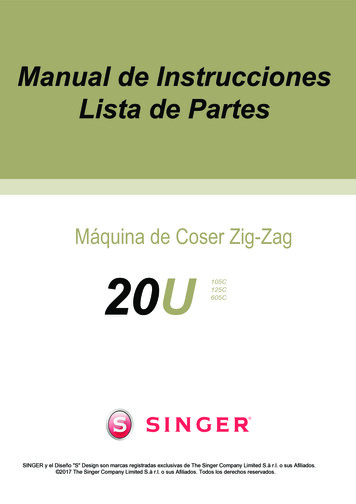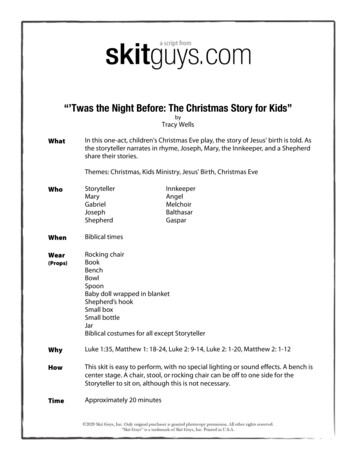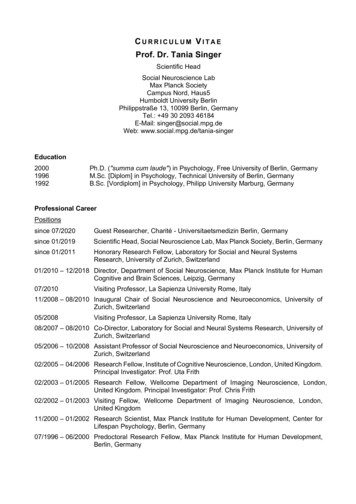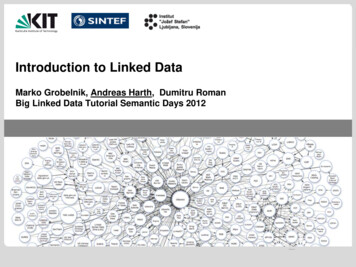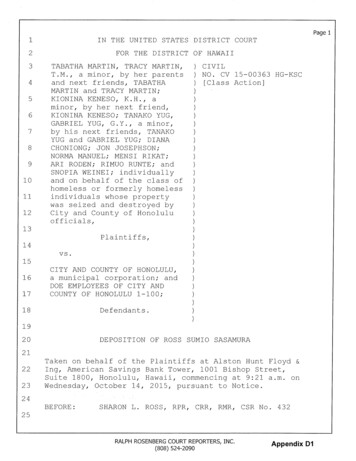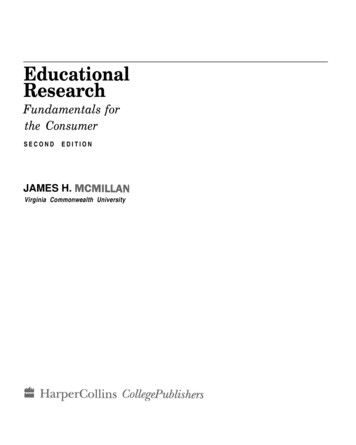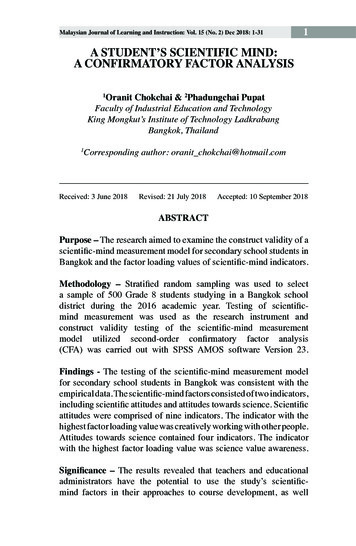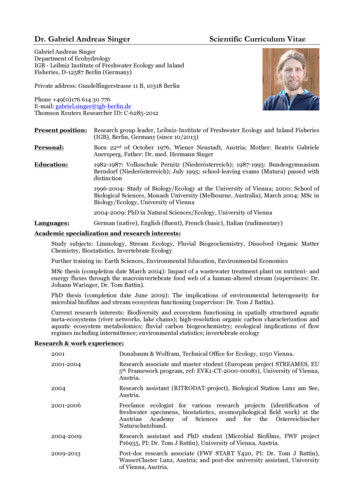
Transcription
Dr. Gabriel Andreas SingerScientific Curriculum VitaeGabriel Andreas SingerDepartment of EcohydrologyIGB - Leibniz Institute of Freshwater Ecology and InlandFisheries, D-12587 Berlin (Germany)Private address: Gundelfingerstrasse 11 B, 10318 BerlinPhone 49(0)176 614 30 776E-mail: gabriel.singer@igb-berlin.deThomson Reuters Researcher ID: C-6285-2012Present position:Research group leader, Leibniz-Institute of Freshwater Ecology and Inland Fisheries(IGB), Berlin, Germany (since 10/2013)Personal:Born 22nd of October 1976, Wiener Neustadt, Austria; Mother: Beatrix GabrieleAuersperg, Father: Dr. med. Hermann SingerEducation:1982-1987: Volksschule Pernitz (Niederösterreich); 1987-1995: BundesgymnasiumBerndorf (Niederösterreich); July 1995: school-leaving exams (Matura) passed withdistinction1996-2004: Study of Biology/Ecology at the University of Vienna; 2000: School ofBiological Sciences, Monash University (Melbourne, Australia), March 2004: MSc inBiology/Ecology, University of Vienna2004-2009: PhD in Natural Sciences/Ecology, University of ViennaLanguages:German (native), English (fluent), French (basic), Italian (rudimentary)Academic specialization and research interests:Study subjects: Limnology, Stream Ecology, Fluvial Biogeochemistry, Dissolved Organic MatterChemistry, Biostatistics, Invertebrate EcologyFurther training in: Earth Sciences, Environmental Education, Environmental EconomicsMSc thesis (completion date March 2004): Impact of a wastewater treatment plant on nutrient- andenergy fluxes through the macroinvertebrate food web of a human-altered stream (supervisors: Dr.Johann Waringer, Dr. Tom Battin).PhD thesis (completion date June 2009): The implications of environmental heterogeneity formicrobial biofilms and stream ecosystem functioning (supervisor: Dr. Tom J Battin).Current research interests: Biodiversity and ecosystem functioning in spatially structured aquaticmeta-ecosystems (river networks, lake chains); high-resolution organic carbon characterization andaquatic ecosystem metabolomics; fluvial carbon biogeochemistry; ecological implications of flowregimes including intermittence; environmental statistics; invertebrate ecologyResearch & work experience:2001Donabaum & Wolfram, Technical Office for Ecology, 1050 Vienna.2001-2004Research associate and master student (European project STREAMES, EU5th Framework program, ref: EVK1-CT-2000-00081), University of Vienna,Austria.2004Research assistant (RITRODAT-project), Biological Station Lunz am See,Austria.2001-2006Freelance ecologist for various research projects (identification offreshwater specimens, biostatistics, ecomorphological field work) at theAustrian Academy of Sciences and for the ÖsterreichischerNaturschutzbund.2004-2009Research assistant and PhD student (Microbial Biofilms, FWF projectP16935, PI: Dr. Tom J Battin), University of Vienna, Austria.2009-2013Post-doc research associate (FWF START Y420, PI: Dr. Tom J Battin),WasserCluster Lunz, Austria; and post-doc university assistant, Universityof Vienna, Austria.
Teaching experience:1999Assistant instructor, Institute for Botany, University of Vienna2000-2004Assistant instructor, Institute of Ecology and Conservation Biology,University of Vienna2003-2011Academic lecturer, International Postgraduate Training Course inLimnology (IPGL), Institute of Limnology, Mondsee, Austrian Academy ofSciences2002-2008Project-leader and instructor in secondary education,WienerLernzentrum (www.walz.at), Oswaldgasse 33, 1120 Wien2005-2015Academic lecturer, UNESCO-IHE(www.ihe.nl), Delft, The Netherlands2005-2018Academic lecturer and assistant instructor, Department of Limnology andMicrobial Oceanography (former Freshwater Ecology), University of Vienna2014-2017Graduate school lecturer, IGB BerlinInstituteofWaterw@lz-EducationCareer breaks10/1995-6/1996Obligatory military service2/2014-3/2014Birth of son3/2015-5/2015Parental care1/2017-3/2017Birth of daughter and family careAwards and fellowships:Ruttner-Preis 2006 of the Societas Internationalis Limnologiae (SIL) AustriaUmwelt-Preis 2009 der Stadt WienHanse-Wissenschaftskolleg Junior Fellowship (12 months, Delmenhorst, Germany)ERC-Starting Grant 2016Third-party funded research projects:PlanktoTrait – Trait-based biodiversity and multitrophic dynamics under external forcing: acombined planktotron and modelling approach (DFG SI 1668/1-1, Co-PI, 257.000,-, 2014-2017)Illuminating Lake Ecosystems (Leibniz Competition 2014, SAW-2015-IGB-1, Co-PI, 998.000,-, 2015-2018)Urban Water Interfaces (DFG Research Training Group, GRK 2032/1, PhD-Supervisor, 4.800.000,-, 2015-2019)FLUFLUX – Fluvial meta-ecosystem functioning: Unravelling regional ecological controls behindfluvial carbon fluxes (ERC-2016-STG 716169, PI, 1.487.000,-, 2017-2022)EUROFLOW – A European training and research network for environmental flow management inriver basins (Horizon 2020 MSCA-ITN-2017 765553, Co-Applicant, 4.099.318,-, 2017-2021)Mentoring of students and post-docs:Ann-Kathrin Chlup (MSc 2006), Gerald Hochedlinger (MSc 2007), Fathima Farveen (MSc 2007),Marcellin Rutegwa (MSc 2010), Fred Omengo (MSc 2010), Sabrina Hengsberger (MSc 2013),Barbara Behounek (MSc 2013, current PhD), Christina Fasching (PhD 2015), Thomas Fuss (MSc2015), Roland Corti (post-doc 2014-2015), Hoseung Jung (MSc 2015), Maria Isabel Arce (post-doc2014-2018), Clara Romero (current PhD), Jeremy Fonvielle (current PhD), Frank Masese (post-doc2017-2019), Lukas Thuile Bistarelli (current PhD).Reviewing activities for funding institutions and scientific journals:German Research Foundation (DFG, Germany); Österreichische Agentur für Internationale Mobilitätund Kooperation in Bildung, Wissenschaft und Forschung (OeAD, Austria); National ScienceFoundation USA (NSF)Aquatic Microbial Ecology, Aquatic Sciences, Biodiversity and Conservation, Biogeochemistry,Biogeosciences, Canadian Journal of Microbiology, Ecology, Ecological Indicators, Ecosphere,Ecosystems, Environmental Microbiology, Environmental Science and Technology, FEMSMicrobiology Ecology, Frontiers in Ecology and Evolution, Frontiers in Microbiology, Freshwater
Science (Journal of the North American Benthological Society), Fundamental and AppliedLimnology, Geochimica et Cosmochimica Acta, Geophysical Research Letters, Global Change Biology,Hydrological Processes, Limnologica, Limnology and Oceanography, Limnology and OceanographyMethods, Marine and Freshwater Research, Marine Ecology Progress Series, Nature Climate Change,Nature Communications, Oecologia, Oikos, Proceedings of the National Academy of Sciences USA,Science of the Total Environment, Scientific Reports, The ISME Journal, Water Research.Further activities:Organising committee of the international meeting of young scientists in limnology “Fresh Blood forFresh Water” in Lunz am See, May 16-18 2008, July 2-4 2010, February 27-March 1 2013.ICBM Summer School 2013 - Biogeochemistry of tidal flats and beaches of the southern North Seacoast (Wadden Sea), Spiekeroog and Oldenburg, August 10-24 2013.SMIRES (“Science and Management of intermittent rivers and ephemeral streams”, COST ActionCA15113, May 2016-April2020): Co-Chair and Grant Holder Scientific Representative.Panel memberships: Tenure-track junior research group leadership at IGB 2014, W3-Professorshipin Ecohydrology at Humboldt University and IGB 2015.Professional affiliations:Society for Freshwater Science (SFS, former NABS), Societas Internationalis Limnologiae (SIL),Association for the Sciences of Limnology and Oceanography (ASLO)Invited talks:Singer G & TJ Battin 2009. Towards ecosystem-level pollution ecology: Integrative responses ofinvertebrate consumers to nutrient enrichment. Workshop “Ecological responses of streams tonutrient enrichment”, University College Cork, Ireland, February 23-24 2009.Singer G 2011. New research trajectories for running water carbon biogeochemistry - Moving ontolarger scales and beyond concentration. Hearing for working group leader position, WasserClusterLunz Biological Station, September 22 2011.Singer G 2012. Riverine carbon biogeochemistry – mechanisms and players behind bulk fluxes.Hearing for junior research group leader position, IGB – Leibniz Institute of Freshwater Ecology andInland Fisheries, December 18 2012.Singer G 2014. Signatures of dissolved organic matter in a dendritic stream meta-ecosystem:Tracing upstream landscape and fluvial processes. Seminar at University of Potsdam, June 23 2014.Singer G 2015. A Lagrangian travel through the fluvial meta-ecosystem: Following molecules fromcontinental soils to the (deep) sea. Hanse Wissenschaftskolleg Fellow Lecture, Delmenhorst, January14 2015.Singer G 2016. Fluvial organic matter (processing): Deeper Meanings of Catchment Integration.Seminar at University of Uppsala, Department of Limnology, January 14 2016.Singer G 2016. Fluvial organic matter (processing): Deeper Meanings of Catchment Integration.HELENA Lecture Series “Environmental Sciences”, Helmholtz Zentrum München, February 1 2016.Singer G 2016. The dance between molecules and microbes. Seminar at Institute of GroundwaterEcology, Helmholtz Zentrum München, February 2 2016.Singer G 2016. Organic matter processing in river networks: looking behind ecosystem metabolismand CO2 evasion. Kolloquium Wasserwesen, TU Berlin, February 8 2017.Contributions to workshops and conferences (first authorships only):Singer G, Marchesani C, Weigelhofer G, Panzenböck M & TJ Battin 2002. Streames-Austria: Workin Progress. Poster, national SIL-conference, Lunz, Austria, October 23-25 2002.Singer GA, Weigelhofer G, Panzenböck M, Marchesani C & TJ Battin 2003. Effects of a wastewatertreatment plant on the energy flow through the macroinvertebrate community in an urban stream.51st annual meeting North American Benthological Society (NABS), Athens, Georgia, May 27-312003.Singer GA, Panzenboeck M, Weigelhofer G, Marchesani C, Wanek W & TJ Battin 2003. Memoryeffect of carbon fractionation in periphytic biofilms: does flow history matter? 5th Austrian Workshop"Stable Isotopes in Ecological and Earth Sciences", Innsbruck, Austria, November 7-8 2003.
Singer GA, Panzenboeck M, Weigelhofer G, Marchesani C & TJ Battin 2004. Response of a streammacroinvertebrate community to a wastewater treatment plant as revealed by stable C- and Nisotopes. 52nd annual meeting NABS, Vancouver, Canada, June 6-11 2004.Singer GA & TJ Battin 2005. Consumer-resource stoichiometry in stream invertebrates: effects ofallochthonous inputs on invertebrate stoichiometry, biodiversity and food chain properties. Poster,Meeting of the American Society of Limnology and Oceanography (ASLO), Santiago de Compostela,Spain, June 19-24 2005.Singer GA, Besemer K, Hödl I-A, Roura-Carol M & TJ Battin 2006. Microbial controls of nutrientand carbon cycling in heterogenous flow landscapes. Poster, International Society of MicrobialEcology ISME-11, Vienna, Austria, August 20-25 2006.Singer GA, Hödl I-A, Besemer K, Sollböck E & TJ Battin 2006. The LunzeRinnen – introducing anew dimension of experimental research in stream ecology. Construction of large-scale streamsidemesocosms and results of first experiments. Poster, national SIL-conference, Innsbruck, Austria,October 22-24 2006.Singer GA, Hödl I-A, Besemer K. & TJ Battin 2007. Wild water slime: Microbial diversity andspatial structure of periphytic biofilms controlling stream ecosystem functions in landscapes ofincreasing flow heterogeneity. EURODIVERSITY meeting, Paris, France, October 3-5 2007.Singer GA, Besemer K, Hoedl I-A, Hochedlinger G., Chlup A-K, Schmitt-Kopplin P & TJ Battin2008. Favourite meals going down the drain: How periphytic biofilms control stream carbondynamics. Poster, ISME-12, Cairns, Australia, August 17-22 2008.Singer GA, Besemer K, Hoedl I-A, Hochedlinger G, Chlup, A-K, Schmitt-Kopplin P & TJ Battin2008. Favourite meals going down the drain: How periphytic biofilms control stream carbondynamics. Poster, BIOFILMS III conference, Munich, Germany, October 6-8 2008.Singer GA, Besemer K, Hoedl I-A & TJ Battin 2009. What is a greedy ant and why does it eat somuch sugar? National SIL-conference, Salzburg, Austria, October 26-28 2009.Singer GA, Besemer K, Hoedl I-A & TJ Battin 2010. Carbohydrate monomer uptake at biofilm andstream ecosystem scale. ASLO-NABS Meeting, Santa Fe, New Mexico, USA, June 6-11 2010.Singer GA, Besemer K, Hengsberger S, Bertuzzo E, Dittmar T & TJ Battin 2012. Processing ofterrestrially derived dissolved organic matter in an Alpine stream network. Soil organic matter SOM5, Ascona, Switzerland, October 7-11 2012.Singer GA, Wilhelm L, Fasching C, Besemer K, Niggemann J, Steier P, Dittmar T & TJ Battin 2013.Consequences of Alpine glacier retreat on the biogeochemistry and microbial biodiversity of glacierstreams. SEFS 8, Münster, Germany, July 1-July 5 2013.Singer GA, Besemer K, Bertuzzo E, Dittmar T & TJ Battin 2014. Signatures of dissolved organicmatter in a dendritic stream meta-ecosystem: tracing upstream landscape and fluvial processes.JASM Meeting, Portland, USA, May 18-23 2014.Singer GA, Besemer K, Wilhelm L, Fasching C, Niggemann J, Steier P, Bertuzzo E, Dittmar T & TJBattin 2014. Geo-metabolomics in Alpine systems: Glaciers and fluvial networks. GeometabolomicsWorkshop, Hanse-Wissenschaftskolleg, Delmenhorst, Germany, Nov 24-28 2014.Singer GA, Besemer K, Wilhelm L, Dittmar T & TJ Battin. Linking high resolution descriptions ofdissolved organic matter and microbial community composition in Alpine stream environments.ASLO Meeting, Granada, Spain, February 22-27 2015.Publications (ISI-listed, coauthorships with indicated contribution, top 5 indicated by *):1. Singer GA, Panzenboeck M, Weigelhofer G, Marchesani C, Waringer J, Wanek W & TJ Battin2005. Flow history explains temporal and spatial variation of carbon fractionation in periphyticbiofilms. Limnology and Oceanography 50(2): 706-712.2. Singer GA & TJ Battin 2007. Anthropogenic subsidies alter consumer-resource stoichiometry,biodiversity and food-chain properties in a recipient stream. Ecological Applications 17(2): 376-389.3. Solimini AG, Singer GA, Martì E, Battin TJ, Gafny S, Gerino M, Morais M, Puig MA, Pusch M,Ruggiero A, Voreadou C & F Sabater 2005. Nutrient transient storage by the invertebrate assemblagein streams with constrasting nutrient loads. Verhandlungen der Internationalen Vereinigung fürLimnologie 29: 807-810. [contribution: description of project-wide standard operating procedures, planning, fieldwork, data analysis, manuscript writing]
4. Singer GA, Besemer K, Hödl I-A., Chlup A-K, Hochedlinger G, Stadler P & TJ Battin 2006.Microcosm design and evaluation to study stream microbial biofilms. Limnology and OceanographyMethods 4: 436-447.5. Besemer K, Singer GA, Limberger R, Chlup A-K, Hochedlinger G, Hödl I-A, Baranyi C & TJBattin 2007 Biophysical controls on community succession in stream biofilms. Applied andEnvironmental Microbiology 73: 4966-4974. [contribution: planning, experimental work, data analysis]6. Besemer K, Hödl I-A, Singer GA & TJ Battin 2009. Architectural differentiation reflects bacterialcommunity structure in stream biofilms. The ISME Journal 3: 1318-1324. [contribution: planning,experimental work]7. Besemer K, Singer GA, Hödl I-A & TJ Battin 2009. Bacterial community composition andbiodiversity of stream biofilms in spatially variable flow environments. Applied and EnvironmentalMicrobiology 75:7189-7195. [contribution: planning, experimental work, data analysis, manuscript writing]8. Bottacin-Busolin A, Singer GA, Zaramella M, Battin TJ & A Marion 2009. Effects of streambedmorphology and biofilm growth on the transient storage of solutes. Environmental Science &Technology, 43, 7337-7342. [contribution: all planning and field/lab work, data analysis, manuscript writing]9. Singer GA, Besemer K, Schmitt-Kopplin P, Hödl I-A & TJ Battin 2010. Physical heterogeneityincreases biofilm resource use and its molecular diversity in stream mesocosms. PLoS ONE 5(4):e9988. doi:10.1371/journal.pone.0009988.10. Hall EK, Singer GA, Kainz MJ & TJ Lennon 2010. Evidence for a temperature acclimationmechanism in bacteria: an empirical test of a hypothesized membrane-mediated trade-off.Functional Ecology 24: 898-908, doi: 10.1111/j.1365-2435.2010.01707.x. [contribution: data analysis,manuscript writing]11. Singer GA, Besemer K, Hochedlinger G, Chlup A-K & TJ Battin 2011. Monomeric carbohydrateuptake and structure-function coupling in stream biofilms. Aquatic Microbial Ecology 62: 71-83.12. Hall EK, Singer GA, Pölzl M, Hämmerle I, Schwarz C, Daims H, Maixner F & TJ Battin 2011.Looking inside the box: using Raman microspectroscopy to deconstruct microbial biomassstoichiometry one cell at a time. The ISME Journal 5: 196-208, doi: 10.1038/ismej.2010.115.[contribution: data analysis, manuscript writing]13. Hödl I, Hödl J, Wörman A, Singer GA, Besemer K & TJ Battin 2011. Voronoi tesselationcaptures very early clustering of single primary cells as induced by interactions in nascent biofilms.PLoS ONE 6(10): e26368. doi:10.1371/journal.pone.0026368. [contribution: experimental work, dataanalysis, manuscript writing]14. Welti N, Bondar-Kunze E, Singer GA, Tritthart, M, Zechmeister-Boltenstern S, Hein T & GPinay 2012. Large-scale controls on potential respiration and denitrification in riverine floodplains.Ecological Engineering 42: 73-84. [contribution: data analysis, manuscript writing]15. Striebel M, Singer GA, Stibor H & T Andersen 2012. Trophic overyielding: Phytoplanktondiversity promotes zooplankton productivity. Ecology 93 (12): 2719-2727. [contribution: data analysis,manuscript writing]16. Singer GA, Fasching C, Wilhelm L, Niggemann J, Steier P, Dittmar T & TJ Battin 2012.Biogeochemically diverse organic matter in Alpine glaciers and its downstream fate. NatureGeoscience 5: 710-714, doi:10.1038/ngeo1581.17. Wilhelm L, Singer GA, Fasching C, Battin TJ & K Besemer 2013. Microbial biodiversity inglacier-fed streams. The ISME Journal 7: 1651-1660, doi: 10.1038/ismej.2013.44. [contribution: studyplanning, field work, data analysis, manuscript writing]18. Ceola S, Hödl I, Adlboller M, Singer GA, Bertuzzo E, Mari L, Botter G, Waringer J, Battin TJ &A Rinaldo 2013. Hydrologic variability affects invertebrate grazing on phototrophic biofilms instream microcosms. PLoS ONE 8(4): doi:10.1371/journal.pone.0060629. [contribution: study planning,data analysis, manuscript writing]19. Minaya V, McClain ME, Moog O, Omengo F & GA Singer 2013. Scale-dependent effects of ruralactivities on benthic macroinvertebrates and physico-chemical characteristics in headwater streamsof the Mara River, Kenya. Ecological Indicators 32: 116-122. [contribution: data analysis, manuscript writing,student guidance]20. Besemer K, Singer GA, Quince C, Bertuzzo E, Sloan W & TJ Battin 2013. Headwaters arecritical reservoirs of microbial diversity for fluvial networks. Proceedings of the Royal Society B 280(1771): 20131760, doi: 10.1098/rspb.2013.1760. [contribution: study planning, field work, data analysis,manuscript writing]
21. Loisl F, Singer GA & H Keckeis 2014. Method-integrated fish assemblage structure at twospatial scales along a free-flowing stretch of the Austrian Danube. Hydrobiologia 729: 77-94, doi:10.1007/s10750-013-1588-4. [contribution: data analysis, manuscript writing]22. Peter H, Singer GA, Preiler C, Chifflard P & TJ Battin 2014. Scales and drivers of temporalpCO2 dynamics in an Alpine stream. Journal of Geophysical Research Biogeosciences 05/2014,doi: 10.1002/2013JG002552. [contribution: data analysis, manuscript writing]23. Wilhelm L, Besemer K, Fasching C, Urich T, Singer GA, Quince C & TJ Battin 2014. Rare butactive taxa contribute to community dynamics of benthic biofilms in glacier-fed streams.Environmental Microbiology: doi:10.1111/1462-2920.12392. [contribution: study planning, field work, dataanalysis, manuscript writing]24. Fasching C, Behounek B, Singer GA & TJ Battin 2014. Microbial degradation of terrigenousdissolved organic matter and consequences for carbon cycling in brown-water streams. ScientificReports 4: 4981, doi: 10.1038/srep04981. [contribution: study planning, data analysis, manuscript writing]25. Ceola S, Bertuzzo E, Singer G, Battin TJ, Montanari A & A Rinaldo 2014. Hydrologic controls onbasin-scale distribution of benthic invertebrates. Water Resources Research 50 (4): 2903-2920,doi: 10.1002/2013WR015112. [contribution: data analysis, manuscript writing]26. Gessner MO, Hinkelmann R, Nützmann G, Jekel M, Singer G, Lewandowski J, Nehls T & MBarjenbruch 2014. Urban water interfaces. Journal of Hydrology 514: 226-232. [contribution:manuscript writing]27. Widder S, Besemer K, Singer GA, Ceola S, Bertuzzo E, Quince C, Sloan WT, Rinaldo A & TJBattin 2014. Fluvial network organization imprints on microbial co-occurrence networks.Proceedings of the National Academy of Sciences 111 (35): 12799-12804, doi:10.1073/pnas.1411723111. [contribution: study planning, field work, data analysis, manuscript writing]28. Haggerty R, Ribot M, Singer GA, Marti E, Argerich A, Agell G & TJ Battin 2014. Ecosystemrespiration increases with biofilm growth and bedforms: Flume measurements with resazurin. JGRBiogeosciences 119: 2220-2230, doi: 10.1002/2013JG002498. [contribution: data analysis, manuscriptwriting]29. Hofhansl F, Schnecker J, Singer G & W Wanek 2015. New insights into mechanisms drivingwood production in tropical forests. New Phytologist 205: 137-146. [contribution: data analysis,manuscript writing]30. Osterholz H, Singer GA, Wemheuer B, Daniel R, Simon M, Niggemann J & T Dittmar 2016.Deciphering associations between dissolved organic molecules and bacterial communities in a pelagicmarine system. The ISME Journal 10 (7): 1717-1730, doi: 10.1038/ismej.2015.231. [contribution: dataanalysis, manuscript writing]31. Burian A, Schagerl M, Yasindi A, Singer GA, Kaggwa MN & M Winder 2016. Benthic-pelagiccoupling drives non-seasonal zooplankton blooms and restructures energy flows in a tropical foodweb. Limnology & Oceanography 61: 795-805, doi: 10.1002/lno.10241 [contribution: data analysis,manuscript writing]32. Bodmer P, Heinz M, Pusch M, Singer GA & K Premke 2016. Carbon dynamics and their link toDOM quality across contrasting stream ecosystems. Science of the Total Environment 553:574-586.[contribution: data analysis, manuscript writing]33. Sieczko A, Demeter K, Singer G, Tritthart M, Preiner S, Mayr M, Meisterl K & P Peduzzi 2016.Aquatic methane dynamics in a human-impacted river-floodplain of the Danube. Limnology &Oceanography: doi: 10.1002/lno.10346. [contribution: laboratory and data analysis, manuscript writing]34. Schelker J, Singer G, Ulseth A, Hengsberger S & TJ Battin 2016. CO2 evasion from a steep, highgradient stream network: importance of seasonal and diurnal variation in aquatic pCO2 and gastransfer. Limnology and Oceanography 61: 1826-1838, doi: 10.1002/lno.10339. [contribution: studydesign, field and laboratory work, data analysis, manuscript writing]35. Baranov V, Lewandowski J, Romeijn P, Singer G & S Krause 2016. Effects of bioirrigation ofnon-biting midges (Diptera: Chironomidae) on lake sediment respiration. Scientific Reports, doi:10.1038/srep27329. [contribution: data analysis, manuscript writing]36. Kalinkat G, Cabral JS, Darwall W, Ficetola GF, Fisher JL, Giling DP, Gosselin M-P, Grossart H-P,Jähnig SC, Jeschke JM, Knopf K, Larsen S, Onandia G, Pätzig M, Saul W-C, Singer G, Sperfeld E & IJaric 2016. Flagship umbrella species needed for the conservation of overlooked aquatic biodiversity.Conservation Biology 31(2): 481-485. [contribution: manuscript writing]
37. Fuß T, Behounek B, Ulseth AJ & GA Singer 2017. Land use controls stream ecosystemmetabolism by shifting dissolved organic matter and nutrient regimes. Freshwater Biology 62: 582599, doi: 10.1111/fwb.12887.38. Grubisic M, Singer G, Bruno MC, van Grunsven RHA, Manfrin A, Monaghan MT & F Hölker2017. Artificial light at night decreases biomass and alters community composition of benthicprimary producers in a sub-alpine stream. Limnology and Oceanography, doi: 10.1002/lno.10607.[contribution: study planning, data analysis, manuscript writing]39. Ulseth AJ, Bertuzzo E, Singer GA, Schelker J & TJ Battin 2017. Climate-induced changes inspring snowmelt impact ecosystem metabolism and carbon fluxes in an Alpine stream network.Ecosystems, doi: 10.1007/s10021-017-0155-7. [contribution: study design, field work, data analysis, manuscriptwriting]40. Gall A, Uebel U, Ebensen U, Hillebrand H, Meier S, Singer G, Wacker A & M Striebel 2017.Planktotrons: A novel indoor mesocosm facility for aquatic biodiversity and food web research.Limnology & Oceanography Methods 15: 663-677. [contribution: study design, data analysis, manuscriptwriting]41. Ladwig R, Heinrich L, Singer G & M Hupfer 2017. Sediment core data reconstruct themanagement history and usage of a heavily modified urban lake in Berlin, Germany. EnvironmentalScience and Pollution Research (accepted), doi 10.1007/s11356-017-0191-z. [contribution: data analysis,manuscript writing]42. Manfrin A, Singer G, Larsen S, Weiss N, van Grunsven RHA, Weiss N-S, Wohlfahrt S, MonaghanMT & F Hölker 2017. Artificial light at night affects organism flux across ecosystem boundaries anddrives community structure in the recipient ecosystem. Frontiers in Environmental Science, doi:10.3389/fenvs.2017.00061. [contribution: data analysis, manuscript writing]43. Lesaulnier CC, Herbold CW, Pelikan C, Berry D, Gerard C, Le Coz X, Gagnot S, Niggemann J,Dittmar T, Singer GA & A Loy 2017. Bottled aqua incognita: Microbiota assembly and dissolvedorganic matter diversity in natural mineral waters. Microbiome 5: 126, doi; 10.1186/s40168-0170344-9. [contribution: laboratory and data analysis, manuscript writing]44. Grubisic M, Singer G, Bruno MC, van Grunsven RHA, Manfrin A, Monaghan MT & F Hölker. Apigment composition analysis reveals community changes in stream periphyton under low-levelartificial light at night. Limnologica (accepted). [contribution: study planning, data analysis, manuscriptwriting]45. Singer GA, Omengo F, McClain ME & TJ Battin. Land use impacts the quality of organic carbonand its metabolism in the headwaters of the Mara River catchment, Kenya. Biogeochemistry(submitted).Popular science publications, news coverage, scientific outreach:Zweimüller I, Guttmann S, Singer GA, Schober E-M & A Weissenbacher (2000). Eine neue Fischartfür Österreich - Neogobius syrman (Nordmann, 1940). Österreichs Fischerei 53 (5/6): 186-189.National newspaper Der Standard (Gabriel Singer, Katharina Besemer, Tom J. Battin):Bakterienfauna reinigt Gewässer. April 6 2010.National newspaper Der Standard (Tom Battin, Gabriel Singer, Katharina Besemer, ChristinaFasching, Linda Wilhelm): Der Bach, ein Superorganismus. April 12 2011.Ö1-Radiokolleg „Quellen des Lebens – Ressource Wasser“. August 1-4 2012.National newspaper Der Standard (Tom Battin, Gabriel Singer, Katharina Besemer, ChristinaFasching, Linda Wilhelm, Peter Steier): Gletscher funktionieren als „Tiefkühltruhen“ für Kohlenstoff.September 24 2012.National newspaper Der Standard (Katharina Besemer, Gabriel Singer, Tom J. Battin): MikrobielleDiversität ist in kleinen Bächen am höchsten. October 2 2013.Newspaper Wiener Zeitung (Katharina Besemer, Gabriel Singer, Tom J. Battin): Vielfalt vonMikroben schwindet flussabwärts. October 2 2013.National newspaper Der Standard (Tom Battin et al.): Biofilme fungieren als Fingerabdruck derUmweltbedingungen in Flusslandschaften. August 19 2014.Wild & Scenic Rivers Film Festival, Berlin. Wissenschaftlicher Podiumsgast beimFlussForscherMatinee zum Thema „Nutzungskonflikte, Renaturierung, Wiederansiedlung“. January22-24 2016.
National newspaper Die Süddeutsche Zeitung (Gabriel Singer et al.): Himmelsglühen,Lichtverschmutzung. Wenn der Mensch der Natur die Nacht stiehlt. October 2 2016.
Dr. Gabriel Andreas Singer Scientific Curriculum Vitae Gabriel Andreas Singer Department of Ecohydrology IGB - Leibniz Institute of Freshwater Ecology and Inland Fisheries, D-12587 Berlin (Germany) Private address: Gundelfingerstrasse 11 B, 10318 Berlin Phone 49(0)176 614 30 776 E-mail: gabriel.singer@igb-berlin.de


